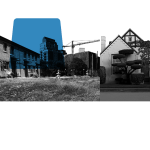In the tale of Mariposa’s creation, we see subplots that are important in many successful planning initiatives. We see a tailored response to specific community needs, intentionality in connecting affordable homes with services and commerce, and the adaptation and use of emerging tools (such as health impact assessments). There are good reasons to lift up individual examples like Mariposa. As well as serving its residents, DHA’s work will inspire people, build support for more quality developments, and offer a template for good technical practices. This kind of civic entrepreneurship — where responsibility meets creativity — deserves celebrating no matter where you sit.
Yet cities and states that want to be quality-of-life innovators must also look beyond individual developments. Adjusting our view past Mariposa to Denver as a whole, and applying a broader lens — with an eye toward public health — reveals the need for regional thinking and planning.
Environmental health issues related to housing and infrastructure exist throughout Denver. As in many cities, there are neighborhood-level disparities in health risks (e.g., poor air quality, brownfields siting, overcrowding) as well as health assets (e.g., access to parks, green space, and grocery stores).
In parts of Denver, the pending expansion of Route 70 will add to the air pollutant burdens already disproportionately shouldered by residents of low-income neighborhoods like Elyria-Swansea. There, children living by the highway have 40% higher rates of asthma hospitalization than kids in the city as a whole.
Although Denver has committed to building new affordable homes for those displaced by the freeway expansion, residents of Elyria-Swansea continue to struggle with deteriorating air quality. The health risks caused by the freeway are compounded by neighborhood pollution from freight and industry as well as a lack of sidewalks, unclean and unsafe parks, and other issues.
Overcoming systemic disadvantage requires quality planning strategies to guide individual projects as well as strategies to address the neighborhood-based nature of many public health problems.
In other words, Elyria-Swansea’s difficulty is not one of a highway plan alone. Health burdens and benefits are frequently cumulative issues that concentrate on a neighborhood scale. The challenges that residents of Elyria-Swansea face reflect a long history of policies and practices that make the clustering of toxin exposures and other health threats commonplace in poor neighborhoods.
Overcoming systemic disadvantage requires quality planning strategies to guide individual projects (such as those deployed by DHA) as well as strategies to address the neighborhood-based nature of many public health problems. We need to meet the needs of all neighborhoods, with a particular focus on the populations hit hardest by unhealthy environments. Regional strategies are fundamental to this.
1 ) Improve the planning process.
Planning should be informed by both community participation and robust data. Policymakers should ensure that all groups — including the vulnerable — are heard. Outreach should include stakeholders such as legal service providers and advocates working on multiple issues, such as affordable housing and environmental justice.
Mechanisms for planning and oversight that account for cumulative health burdens (for example, from multiple industrial permits) are also key. Denver’s requirement that health impact assessments (HIAs) shape neighborhood planning is one excellent step in this direction. This can help the city meet the needs of neighborhood residents and avoid additional environmental burdens. The HIAs should also be used to inform citywide and regionwide planning, with each neighborhood plan considered within the larger city context. This can ensure that resources are allocated to those who have the greatest need.
2) Prioritize housing sites that promote health.
When it comes to planning for affordable housing, developers and local policymakers can provide residents with access to healthier neighborhoods through site selection practices that minimize exposure to environmental burdens. They can also address barriers to regional development. As Brian Smedley notes, tools like the Affirmatively Furthering Fair Housing Rule can help promote development in neighborhoods with better access to healthy resources.
3) Help people live where they want to.
Policymakers can create pathways for families who seek to move to healthier neighborhoods. (This is in addition to the strong need for anti-displacement measures in many areas.) Quality housing mobility programs help residents, particularly those with young children, expand their options throughout the region and outside areas with health risks. Housing authorities may also prioritize residents who live in unhealthy housing or neighborhoods as part of their preference for admission into the Section 8 voucher program.
Expanding housing choice also requires that planners listen to residents and use what they hear to address barriers to residential mobility. An example is coordinated transportation and affordable housing planning for better regional access. Another is outreach to landlords regarding fair housing requirements and benefits, or marketing that informs residents about wider housing choices.
Even as cities lift up their individual housing development successes, we should embrace broader, multipronged planning strategies that ensure all neighborhoods and residents are interconnected and deserving of good health.
Megan Haberle is a member of the BLOCK Project’s Community of Practice and the Director of Housing Policy at the Poverty & Race Research Action Council (PRRAC). She is also editor of PRRAC’s quarterly journal,


